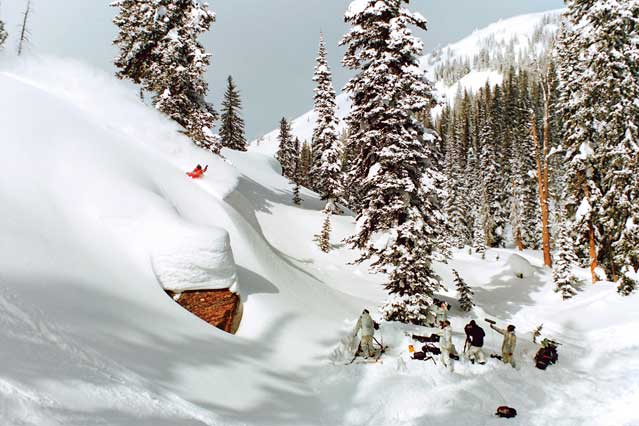IN THE SECOND WEEK of February, a three-minute teaser for a film called The Art of Flight was posted online. Shot by the Jackson, Wyoming, production house Brain Farm and starring Travis Rice, widely regarded as the worldтАЩs best snowboarder, the clip blew upтАФin part due to the formidable ┬нmarketing tentacles of Red Bull, the filmтАЩs primary backer. Within a week, it had been viewed 1.5 million times, ┬нapproximately 1.3 million more times than the trailer for any other snowboarding film in existence. тАЬJustin Timberlake texted me,тАЭ Curt Morgan, the movieтАЩs 29-year-old director, told me shortly after the clip went viral. тАЬ50 Cent posted it.тАЭ
Phantom HD
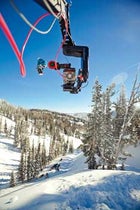 Travis Rice, captured by the Phantom HD.
Travis Rice, captured by the Phantom HD.Cinema Ranger
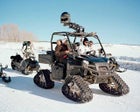 Brain Farm's Cinema Ranger
Brain Farm's Cinema RangerCineflex on a Chairlift
 The Cineflex mounted on a chairlift at Jackson Hole Mountain Resort.
The Cineflex mounted on a chairlift at Jackson Hole Mountain Resort.Brain Farm
 Brain Farm founder Curt Morgan (center) with, from left, Clark Fyans, Travis Rice, Mark Landvik, and Chad Jackson.
Brain Farm founder Curt Morgan (center) with, from left, Clark Fyans, Travis Rice, Mark Landvik, and Chad Jackson.Gabe Langlois
 Cameraman Gabe Langlois.
Cameraman Gabe Langlois.Scotty Lago
 Pro snowboarder Scotty Lago.
Pro snowboarder Scotty Lago.Travis Rice
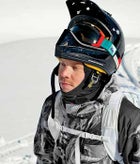 Pro snowboarder Travis Rice.
Pro snowboarder Travis Rice.Pat Moore
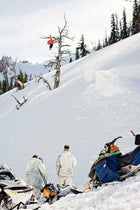 Pat Moore goes big in the Snake River Mountains.
Pat Moore goes big in the Snake River Mountains.╠¤
Hold that thought: 50 Cent posted a link to a trailer for a snowboarding film?
Certainly Flight, which premieres September 7 at New York CityтАЩs Beacon Theater, was reaching a much broader audience than any snowboarding film had before, but it was also wowing action-sports luminaries. тАЬMind-blowing,тАЭ said ┬нAnnie Fast, editor in chief of Transworld Snowboarding. тАЬInsanely beautiful and well crafted,тАЭ said Brian Wimmer, director and founder of the X-Dance Action Sports Film Festival.
While the ridersтАЩ feats are ┬нastonishing, itтАЩs the trailerтАЩs cinematography that is the real star of the show. Thanks to a deep-pocketed investor and a tight relationship with Red Bull, which is picking up the filmтАЩs entire, undisclosed (but certainly multimillion-dollar) tab, Morgan was able to deploy the same arsenal of high-tech toys used by crews on celebrated docs like Planet Earth and Life, ┬нincluding a CineflexтАФa remote-controlled gyro-stabilized ┬нcamera that utilizes software developed for the military. One of many beautiful shots in the trailer is of professional snowboarder Mark Landvik launching from a massive kicker and hand-planting off a pine tree that appears to be the height of a small skyscraper. If the sequence had been shot like every other action-sports filmтАФthat is, by a single cameraman, maybe two, perhaps from a helicopter, using standard-issue high-definition camerasтАФit would have been extraordinarily cool. But ┬нbecause Morgan was able to set up a 12-foot jib for one of his newest gizmos, the super-slo-mo Phantom HD Gold (which is capable of turning one second into 60), itтАЩs extraordinarily cool and also serenely graceful.
What isnтАЩt apparent, of course, is all of the painstaking preparation that went into capturing the sequence. To set up the shot, which was filmed 20 miles from the nearest trailhead in the Snake River Mountains ┬нoutside Jackson, Wyoming, it took six guys on sleds three days to break trail for the camera crew, then another full day to shuttle in the 800 pounds of equipment, including 200 pounds of free weights used as ballast for the PhantomтАЩs jib arm. Once everything was in place, a team of 10 to 12 guysтАФ┬нincluding Rice, ┬нLandvik, and Olympic halfpipe bronze medalist Scotty LagoтАФspent four more days moving an estimated 80 tons of snow to build the 20-foot kicker Landvik and company would launch off.
тАЬIn the commercial world,тАЭ Morgan told me a few days after I watched his crew methodi┬нcally build the ramp, тАЬthat one jump would cost a half-million dollars.тАЭ For Morgan, it was just another day on location for Flight (which as of early July was still in postproduction). Over the past two years, when not directing commercials for blue-chip clients like Visa and shooting scenes for Hollywood films like Jackass 3D, Morgan and crew have been following Rice, Landvik, and a revolving cast of snowboardingтАЩs cool kids around the planet.
Already, theyтАЩd spent a month and a half in Chile and a month in AlaskaтАЩs Tordrillo Mountains, plus stints in Canada and Jackson, with tentative plans to hit British Columbia, Romania, Greece, Austria, and, if they still had the cash, Greenland. Snowmobiles had been crashed, 15 top-of-the-line AStar B3 helicopters rented, and both fireworks and firearms deployed. (Morgan often carries a .50-caliber pistol with him on location.)
YouтАЩll be able to see it all, though not necessarily in the theater. A condition of Red BullтАЩs investment was that Brain Farm produce an accompanying TV show, an eight-episode making-of documentary series. (At press time, Brain FarmтАЩs agents were still in negotiations with networks; the yet unnamed series is expected to debut in early 2012.)
All signs point to Flight becoming the biggest action-sports movie of all time, bypassing its groundbreaking precursor, ThatтАЩs It, ThatтАЩs All, the 2008 film that established Brain Farm as one of the best in the business.
╠¤
ITтАЩS WORTH NOTING that raising the bar in the action-sports genre wasnтАЩt terribly difficult. Ski ┬нmovies tend to all look alike, in large part because there just isnтАЩt much money to be made from them. Snow-porn ┬нfilmmakers generally scrape by, squeezing money from increasingly cash-strapped endemic sponsors and negotiating reduced rates from resorts and heli- or cat-ski operations in exchange for exposure. Following the business model established by ┬нWarren Miller, the down payment for the next film comes from the previous oneтАЩs DVD sales and tour revenue. тАЬMost ski filmmakers are geniuses at doing a lot with a little bit of budget,тАЭ says Jack Shaw, a journalist and ski guide whoтАЩs written about the history of the genre.
Relatively small budgets, usually in the midтАУsix figures for feature-length documentaries made by outfits like Teton Gravity Research and Mack Dawg Productions, naturally limit production values. There have been attempts to break the mold, notably 2005тАЩs First Descent, paid for by Mountain Dew, and 2007тАЩs Steep, an extreme-skiing documen┬нtary that received a wide theatrical release. Both tanked. The former was boring and repet┬н┬нitive and was panned by the filmтАЩs core audience and mainstream viewers alike; the ┬нlatter was good but ultimately not entertaining enough to reel in the general public.
Flight is a different animal entirely. From Brain FarmтАЩs inception in 2008, the ┬нcompany has played the game by its own rules. Rice and Morgan have been friends since they were both 17-year-olds riding for Rossignol. While RiceтАЩs star in the sport ascended, Morgan abandoned it after breaking his back three times in one year. HeтАЩd always loved photo┬нgraphy and film, though, and ┬нafter ┬нattending some workshops at Maine Media College, he began shooting footage for the Kass brothers, Matt and Danny, the New JerseyтАУreared bad boys of snowboarding who would go on to found Grenade Gloves. A few years spent making low-budget films burned Morgan out, and in 2002 he moved back to his hometown of Albany, New York, where he spent a year unloading trucks and playing in a metal band. Until his old friend RiceтАФby now pulling in big sponsorship dollars, most notably from Red Bull and QuiksilverтАФ┬нintervened. тАЬTravis called me and said, тАШWe need to start making movies. I can pay you now. IтАЩve got money,тАЩтАЙтАЭ Morgan says.
Morgan moved into RiceтАЩs house in Jackson, and they began work on their first movie, 2006тАЩs The Community Project. The following year, Morgan and Rice were traveling in New Zealand when they met a film crew that was shooting from helicopters using a revolutionary new camera-stabilization system. The footage blew their minds. A few months later, the two headed back to New Zealand, rented the crewтАЩs equipment, and started filming ThatтАЩs It, ThatтАЩs All.
TITAтАЩs stunning visuals, especially those zoom-out-for-miles shots much of the world first saw in Planet Earth, started ┬нattracting notice from non-action-sports clients, but it was an introduction to Joe Sorge, a wealthy biotech entrepreneur with a home in Jackson, that allowed Morgan to build Brain Farm into the Willy Wonka production house it is today. In 2009, over dinner in Los Angeles, Morgan told Sorge about his fantasy of buying an arsenal of cutting-edge production equipment, including his own Cineflex. Sorge agreed to bankroll an incredible lineup of gearтАФincluding the Phantom, the Cineflex, and an array of other HD and 35mm film cameras (see тАЬThe Toy ChestтАЭ)тАФin exchange for a portion of the company.
тАЬWe have a lot of money in hardware,тАЭ Morgan says. How much? тАЬIтАЩm not sure I want to put a figure on it.тАЭ He thinks about it for a minute: тАЬYou can say millions.тАЭ
Brain Farm now has eight full-time employees and a slick headquarters in a modern loftlike building just outside Jackson. Over the past 18 months, in addition to their projects with Visa and for Jackass 3D, Brain Farm worked on an episode of Expedition Wild, a series on the National ┬нGeographic Channel; filmed commercials for Subaru, NBC/Universal, and Quiksilver; and, most recently, shot a two-minute 3-D spot for Red Bull starring the deaf motocross ┬нrider Ashley Fiolek, which aired in theaters ahead of Thor and Pirates of the ┬нCaribbean: On Stranger Tides.
ONE EVENING WHILE I was in Jackson, Morgan suggested we go for a ride in what he calls the Cinema Truck, a Ford F-250 pick┬нup modified to serve as a rolling platform for the Cineflex. The rig looks menacingтАФblacked out from top to tire and outfitted with what appears to be a large surveillance ┬нdevice on the roof.
In a sense, thatтАЩs what the Cineflex is: a five-axis, extremely-long-distance high-definition camera system developed by the defense industry for spying. Its use is still controlled by International Traffic in Arms Regulations, which required that Brain Farm register it with the State Department.
As Brain Farm producer Chad Jackson steers the truck out onto the road, the camera feed shows up in hi-def on a large screen built into the dash. Morgan twiddles a knob on a remote-control console and the camera spins around to focus on a Subaru trailing us. He zooms in, in, in, until I can just about see the nose hairs of the woman driving. Spinning the camera 180 degrees, he points out a speck in my vision thousands of yards away that turns out to be a bush, and behind it is a mule deer, as crisp as if it were standing on the hood. ItтАЩs unbelievable.
тАЬI consider this an endless dolly,тАЭ Morgan says. He estimates that he uses the Cineflex in approximately 60 percent of Brain FarmтАЩs shots, and though it was initially built to be affixed to helicopters, Morgan has designed custom mounts for a snowmobile, an ATV, a snowcat, and, most recently, a chairlift.
The plan had been for me to tag along as Brain Farm experimented with the new chair┬нlift mount, shooting Rice and Landvik in-bounds at Jackson Hole Mountain Resort, but there wasnтАЩt enough new snow. Instead, Morgan and his crew opted to dig in at one of their favorite filming locations in the Snake River Mountains.
For the dayтАЩs first major shot, the group selected a gap between some trees at the top of a small canyon. Morgan set up by himself, with the Phantom, to one side. First to go was Landvik, who soared out of the woods and over the edge. He tapped a tree in the air, stomped the landing, and rode down to meet the rest of the crew, which included one guy shooting with a traditional long-lens 35mm camera and another using a VariCam to collect footage for the TV show.
тАЬThat was sick,тАЭ Morgan rasped over the radio when Landvik slid to a stop below. тАЬMaybe you can double-tap this time?тАЭ
Landvik laughed. тАЬHeтАЩs so unrealistic,тАЭ he said, his speech slurred by a fat lip and 13 stitches heтАЩd gotten in a recent crash.
One criticism youтАЩll sometimes hear of MorganтАФwho wants every frame to be epicтАФis that he pushes riders too hard, goading them into tricks they might not otherwise attempt.
This turned out not to be an issue for Lago. His jump, which began with a higher, angled ┬нapproach, was absolutely huge, and he, too, tapped the treeтАФonly he didnтАЩt mean to. The glancing blow spun him off-axis, and he found himself 30 feet in the air falling backward, his arms spinning wildly as he tried in vain to stay upright. He crashed in an enormous puff of white. When he ┬нarrived at the bottom, snow was packed into every crevice of his helmet.
тАЬThatтАЩs gonna look epic on the Phantom,тАЭ Landvik said. тАЬYour arms will spin like 50 times.тАЭ
тАЬI wanna yell the worst word right now,тАЭ Lago said, chucking his helmet. тАЬLetтАЩs go build a big fucking jump.тАЭ
I SKIPPED THE NEXT DAYтАЩS shoot, but later that evening I visited Morgan at Brain FarmтАЩs editing suite to see how it had gone. тАЬIt got gnarly out there,тАЭ he said as he queued up a clip heтАЩd been working on. Already heтАЩd laid a moody audio track under the action. (Morgan is also helping produce FlightтАЩs soundtrack, and heтАЩd recently spent a week collaborating with the French musician Anthony Gonzalez, who records under the name M83.) ┬нSlowlyтАФvery, very slowlyтАФScotty LagoтАЩs image ┬нappeared in the frame, and he executed an ┬нimpressive-looking trick I didnтАЩt recognize.
тАЬThese are some of the biggest airs ever,тАЭ Morgan said, noting that what Lago had done was a switch double rodeo 1080. But that wasnтАЩt the gnarly part. Upon impact, Lago kneed himself in the faceтАФhard. тАЬScotty broke his jaw, and now itтАЩs wired shut,тАЭ Morgan said. тАЬWe spent most of the night at the hospital.тАЭ And of course: тАЬWe got it all on film.тАЭ
While Morgan was initially daunted by FlightтАЩs TV component, heтАЩs grown to enjoy the medium. Making ambitious films is unbelievably complicatedтАФand stressfulтАФbut he found that shooting for TV required almost no thought at all. Everything thatтАЩs bad for the big screenтАФinjuries, fights, logistical snafusтАФis great for the small.
тАЬNow I almost love TV more than film,тАЭ he said, adding that with film тАЬit can take a week to get one shot. ThatтАЩs stupid. And all the stuff around that is whatтАЩs actually inter┬нesting to everyone else.тАЭ That said, Brain Farm is still devoting most of its promotional ┬нeffort to the film. After FlightтАЩs world premiere this September in New York, it will tour the U.S., playing in a mix of bigger cities and ski towns before heading to Canada, Europe, Australia, and New Zealand.
Exploiting every possible source of reve┬нnue, Brain Farm will make the film available simul┬нtaneously through the iTunes Store and as a DVD and Blu-ray set; it will also release a limited-edition coffee-table book, The Art of Light, featuring stills and shots by the rotating cast of set photographers. And this past May, Morgan and GonzalezтАФunder the name the Three Corners of the EarthтАФmade a set of songs available on iTunes from their recording sessions, including the one used in the trailer.
In the end, though, Morgan is worried less about the box office than about the filmтАЩs critical reception. While he declined to discuss Brain FarmтАЩs financials with me, I got the distinct impression that their commercial and Hollywood work now brings in the majority of their revenue, and that Morgan views TITA and Flight as gigantic calling cards heтАЩs using to build his companyтАЩs ┬нcelebrity. If thereтАЩs been one major criticism of TITA, itтАЩs that, for all its dazzling visuals, itтАЩs still just snow porn. There isnтАЩt much story.
тАЬOne of the toughest things is to please the coreтАФsomeone who lives and breathes itтАФwhile doing something that speaks to the layman,тАЭ says Rice.
When I reached Morgan on the phone a few weeks later, he was still tinkering with how much тАЬcharacter component,тАЭ as he referred to it, there would be in FlightтАЩs final cut. He knows that every wide-angle shot of an epic jump he edits out will alienate the park rats, while every additional minute of character and story will make it more interesting to mainstream viewers.
In the meantime, Wyoming had been getting pummeled with snow. So much, in fact, that Brain Farm ended up delaying its departure for Revel┬нstoke, and after that Alaska, to finish the Jackson chapter of the film. TheyтАЩd scratched Romania, Greece, and Austria from the plan, and Greenland was looking unlikely. While Morgan told me he could probably ┬нassemble the movie then if he had to, he still wasnтАЩt sure about the filmтАЩs length. When IтАЩd visited him in Jackson, he was leaning toward a feature. Now he wasnтАЩt so certain.
Not that any of these issues were keeping him up at night. In part thatтАЩs because heтАЩs so busy. He was just back from shooting the 3-D Red Bull commercial, as well as a series of ads for the Marines. Or it might be ┬нbecause heтАЩs already begun chewing over his next big projectsтАФincluding, perhaps, a surf film, a snowboarding movie тАЬbased around Antarctica,тАЭ and something shot entirely in 3-D. Or it might simply be that Brain Farm is now successful enough that he doesnтАЩt have to do everything himself. тАЬI used to have 40 jobs,тАЭ Morgan says. Now he can ┬нorchestrate a shoot and not actually have to be there: тАЬItтАЩs dumping out, itтАЩs freezing, and IтАЩm eating a hamburger at a deli.тАЭ


